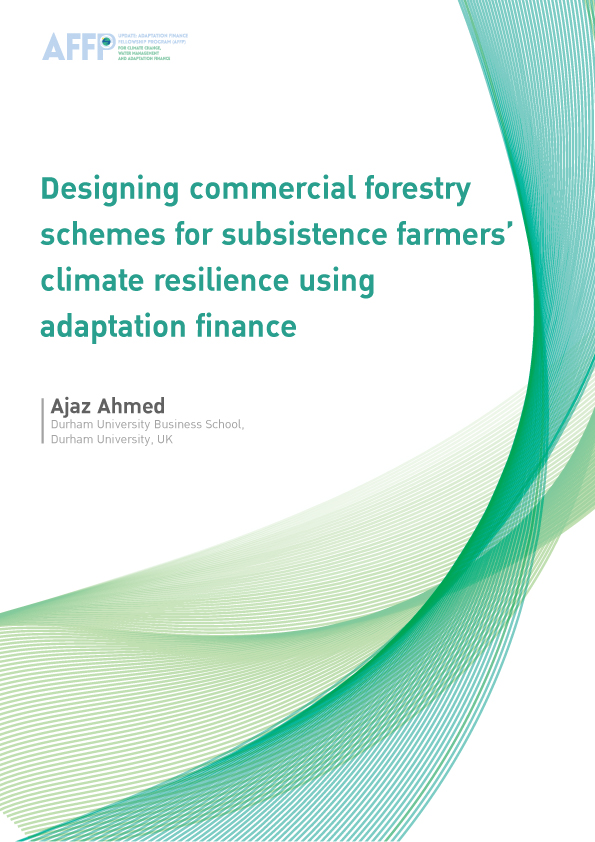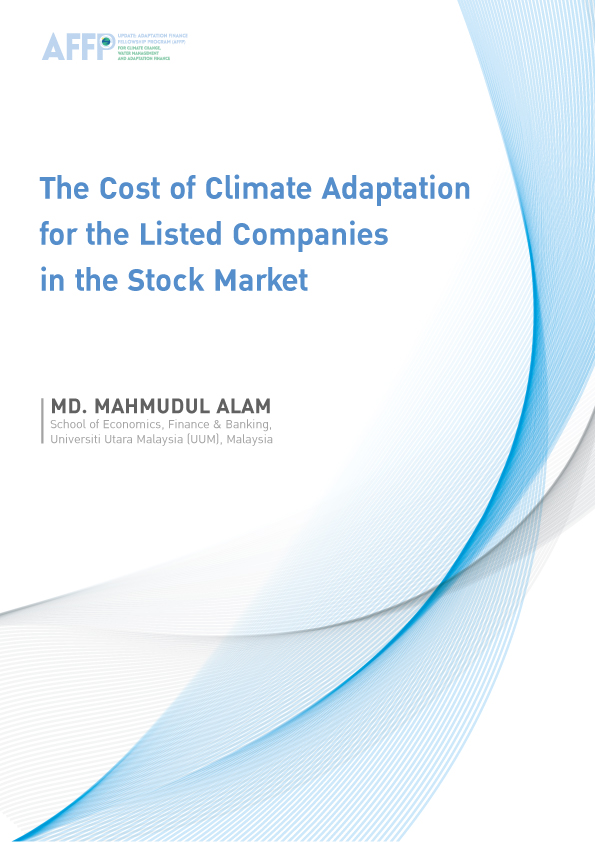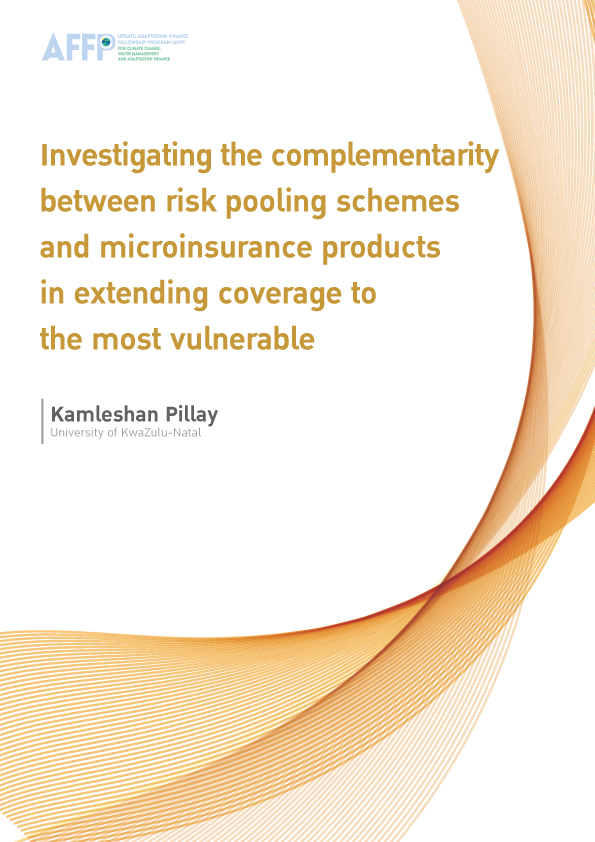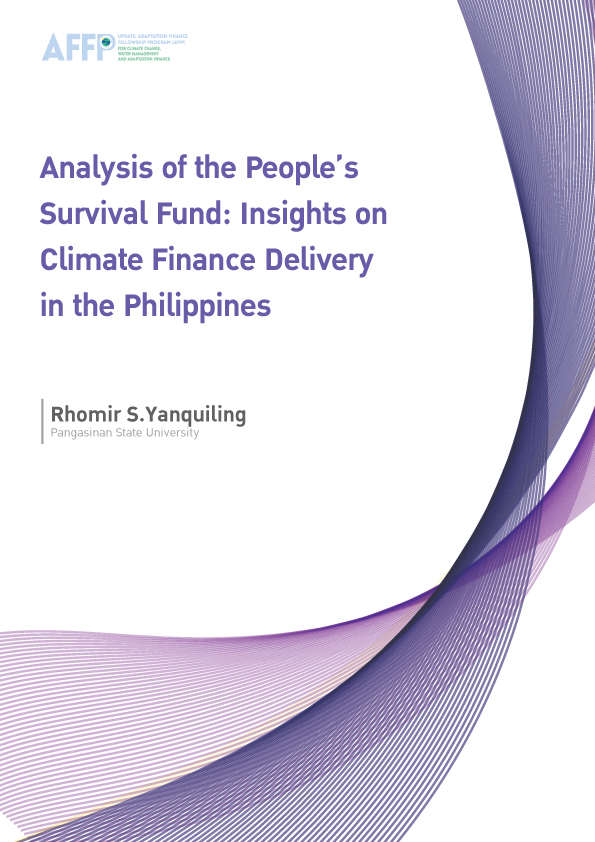
The IDRC, TDRI & Frankfurt School Fellowship Programme
“ADAPTATION FINANCE: LINKING RESEARCH, POLICY AND BUSINESS”
(short: Adaptation Finance Fellowship Programme) identifies, supports and promotes exceptional individuals from the scientific community, policy and private sector who are active in a climate adaptation finance related field. On top of supporting their individual endeavours, the objective of the programme is to bring those groups together to discuss and analyse current challenges and opportunities in adaptation and adaptation finance from policy, private sector and research angle.
This cross-disciplinary and cross-sector exchange contributes to enhanced knowledge sharing and identifying of best practices and approaches in adaptation finance around the globe to make significant advances in adaptation finance, emerging as knowledge leaders, exerting influence, and bringing solutions to the national level.
Research and related topical discussions also based on the reflections among the fellows across research, business and policy will generate powerful ideas, integrate expertise from the private sector, and multiply resources devoted to adaptation finance solutions that will be documented and published e.g. in the Working Paper series or as a special issue in a journal.
LATEST AFFP RESEARCH
Designing commercial forestry schemes for subsistence farmers’ climate resilience using adaptation finance
Ajaz Ahmed
Abstract
Using discrete choice experiment (DCE) and a primary survey of 450 farmers, this study investigated the rural farmers’ willingness to adopt donor-funded commercial forestry schemes (CFS) to align their farming to climate change in the hilly areas of the Northern Pakistan. Results reveal that farmers derive disutility from existing farming practices, which is possibly due to their susceptibility to unfavorable weather changes such as droughts, implying that farmers might prefer to adopt the CFS as an adaptive response.
Farmers are unwilling to pledge a biodiversity area, and demand significantly high compensations for designating a biodiversity area on their farms. This shows that farmers are interested in CFS for their private benefits such as crop diversification rather than the improvement in biodiversity. Findings reveal that farmers prefer their own choice of CFS location on their farm and demand compensation for allowing donor to choose the CFS location. However, farmers are willing to sacrifice some amount of annual payment for choosing CFS location themselves, which indicates farmers’ disinclination to forgo their control on their farmland.
Interestingly, farmers place a positive and significant value on wood share attribute of CFS and are willing to forgo certain amount of annual payment for having a share in the wood. However, the amount of annual payment that farmers are willing to forgo for each level of wood share is significantly lower than the monetary value of respective wood share. This shows that despite limited literacy, farmers have made rational choices while making a trade-off between annual payment and wood share. A more intriguing aspect of this result is that farmers have preferred wood share over annual payment, despite knowing that annual payment has minimal risk and wood share is uncertain. While this indicates that farmers are willing to take some risk for expected returns; it is possible that farmers are unsure of the timely disbursement of annual payment, and hence prefer wood share.
Results of attribute interactions show that aged farmers and farmers with large household size prefer existing agricultural practices and demand additional compensation to sign-up for CFS. Similarly, farmers with relatively large farm size are disinclined to designate greater biodiversity area without additional compensation. Farm households with a greater participation in off-farm work disliked donor choice of CFS location on their farm and they are willing to forgo some amount of annual payment to be able to choose the CFS location themselves. Likewise, educated farmers prefer their own choice of CFS location on their farm. However, farm household further from the nearest market are likely to commit a greater biodiversity area against relatively lower compensations, which implies that households further from market feel more vulnerable and are extra keen to adopt CFS.
The Cost of Climate Adaptation for the Listed Companies in the Stock Market
Md. Mahmudul Alam
Abstract
Climate change is an important factor that directly affects in the agriculture. Therefore, to
adapt with the climate change, agriculture and plantation firms need to take different
initiatives and spend in many ways. If the firm is enlisted as a public listed company, it needs
to bear adaptation cost in physical level, accounting level and stock market level. In the stock
market, investors expect risk premium in order to accept the higher fluctuation or volatility of
the stock price. As climatic events have direct adverse impacts on the financial performance
of agro and plantation companies, it also increases the business risk for these companies.
Therefore, to maintain stability in price, higher equity market risk premium and/or higher
dividend is required. This extra risk premium and extra cost of equity, dividend, can be
considered as the climate change adaptation cost at stock market level. This cost helps agro
and plantation companies to maintain performance at stock market level. Therefore, to
understand the climate change adaptation cost for stock market performance of public listed
agro and plantation companies in Malaysia, this study empirically investigate four specific
objectives – (i) examine the impact of climate change on stock market price volatility (market
risk), (ii) find out the equity market risk premium (market return) for climate change events,
(iii) examine the impact of climate change on the cost of equity (dividend), and (iv) find out
the reflection of climate change on the stock market investor’s behavior.
To fulfill the first and third objectives, the firm level data were collected for 33 Malaysian public listed plantation companies from 2003 to 2016. For the climatic variables, both models considered
El Nino and Flood, and panel regression models were used to draw inferences.
For the second objective, this study conducted event study based on El Nino events that happened from 2009 to 2018. The firm level daily stock price data for 37 companies, market index data, plantation index data, and El Nino data were analyzed to determine risk, return and risk premium for the El Nino events. To fulfill the fourth objectives, a structured questionnaire survey was conducted among the individual investors in Malaysian Stock Market, Bursa Malaysia. To
draw inferences this study estimated Structural Equation Model based on 273 samples. The
overall findings show that climatic events are long term phenomenon which has not adequate
and significant instant impact on the stock price or market return.
However, investors are aware about the negative impacts of climate change on the annual return of the company, and they expect compensation for the climatic risk. Therefore, public listed companies compensate the investors through providing higher dividend in the adverse climatic event year and it also help them to maintain stability in stock price. The findings of the study will help the investors, companies, regulatory agency and policy maker to improve the market
efficiency and to achieve the UN target of sustainable stock exchange initiatives.
International adaptation finance to address planned priorities in
Least Developed Countries
Ana Karla Perea Blazquez
Abstract
International climate finance plays an important role in enhancing adaptation action and has been a key policy response in the international climate change regime. The United Nations Framework Convention on Climate Change (UNFCCC) and the Paris Agreement acknowledge the need for climate finance to take into account the priorities and needs of developing countries, and in particular those that are most vulnerable to climate change impacts, such as Least Developed Countries (LDCs). Developing countries have progressively communicated their adaptation needs and priorities through various channels to the UNFCCC.
However, there is limited information on how the finance provided through the UNFCCC is addressing national adaptation priorities identified by countries. As the funds under the UNFCCC will play a key role in assisting developing countries in their adaptation efforts, it is relevant to better understand countries’ progress in accessing finance through these funds and the type of adaptation measures being implemented to address adaptation priorities.
The purpose of this research is to examine in the ways and extent to which international adaptation finance has supported the implementation of adaptation priorities in LDCs. Specifically, the study aims to provide information on LDCs’ progress in accessing international finance through the funds under the UNFCCC’s financial mechanism to address planned adaptation priorities. The study also aims to provide information on the type of adaptation priorities that are being addressed by the funds under the UNFCCC’s financial mechanism.
The analysis included 221 national projects supported by the SPA, LDCF, SCCF, AF, and GCF in 44 LDCs in Asia and Africa. The analysis considered 44 LDCs: The Strategic Priority on Adaptation (SPA), LDC Fund, Special Climate Change Fund (SCCF), Adaptation Fund (AF), and Green Climate Fund (GCF). In total, 221projects were analysed. Projects in the analysis included national projects, that were approved for implementation or completed. The projects that were analysed also included those that specified a link with the NAPA in terms of alignment with objectives or addressing priority activities. Project information was extracted from the funds’ public databases and integrated into a new database. Details of the projects were analysed using excel spreadsheets and quantitative data was summarized. Adaptation priorities were considered as those specified under the National Adaptation Programmes of Action (NAPAs). NAPAs were used as they provide a large database with the adaptation priorities in a diverse group of LDCs, and are comparable
documents because they were developed based on predefined guidelines.
International adaptation finance channelled through the UNFCCC’s funds is addressing planned adaptation priorities in LDCs. However, there are opportunities to strengthen the range of sectors targeted by projects to address adaptation priorities in other priority sectors, such as the health sector. The results from the study show that LDCs’ progress in accessing international finance to address adaptation priorities varies, with Bangladesh, Bhutan Nepal, Rwanda and Senegal, being the leaders in accessing international finance to address national priorities. Djibouti, Guinea Bissau and Chad are among the countries with a higher percentage of adaptation priorities addressed but with limited finance. Angola, Central African Republic, Democratic Republic of Congo, Liberia, Mauritania, Togo and Yemen constitute the group with the least access to adaptation finance and limited adaptation action.
The different progress of LDCs in accessing international finance to address adaptation priorities reflects that there are opportunities to improve the distribution of adaptation finance to LDCs and target capacity building and finance readiness support to the 19 LDCs with the lowest access to finance. There are also opportunities to better align the project funded by the UNFCCC’s funds to promote that project investments sustainably strengthen in-country adaptation processes.
Investigating the complementarity between risk pooling schemes and microinsurance products in extending coverage to the most vulnerable
Kamleshan Pillay
Abstract
Climate change is expected to make floods across the Western Cape province, South Africa, more frequent and intense (Zuma, 2012). There is a growing demand for insurance products as municipalities have less financial capacity to manage costs from their public budgets. The costs associated with these floods have been estimated to be US $ 66.0 million annually for municipalities (WRI, 2017). Risk pooling is a type of insurance scheme that can be used for this purpose. Payouts from risk pools are seldom sufficient to meet the costs of reconstruction after a flood resulting in a financial gap for the needs of vulnerable communities. An additional microinsurance scheme could be integrated within risk pools could address this concern. Microinsurance is similar to traditional insurance, however, the products are targeted at low-income individuals who have less savings. Premium affordability for the poor may still be a concern in microinsurance products thus subsidization of premiums from risk pooling participants may be required.
The primary aim of this research was to outline how microinsurance could be used within risk pool structures to extend coverage to the most vulnerable individuals affected by flooding events in the Western Cape, South Africa. The most critical factor that determines the solvency estimations and premium costs in the long term is the future costs of flooding events. Under the high climate change scenario (RCP 8.5), future flood costs result in the risk pool being insolvent in 2042 while under a medium climate change scenario (RCP 4.5), this extends to 2054. According to the premium analysis, depending on the climate scenario, premiums will be 5 – 10% more expensive on average. 3 – 6 % of the risk pooling premiums allocated to microinsurance premium subsidization will ensure that stability of the risk pool is maintained under a moderate climate change scenario.
Microinsurance products can be integrated into risk pooling schemes; however, a high degree of subsidization is required, particularly in the developing country context. Total subsidization may be necessary in a South African context as most vulnerable communities have no financial resources to pay for microinsurance premiums. It is critical that microinsurance contract holders must be spatially independent across risk pooling municipalities. If a flood occurs in a risk pooling municipality where all microinsurance policy holders are based, multiple policies would be triggered at the same time. This could impact the solvency of the risk pool resulting the financial reserves being eroded. Risk pools and microinsurance products will not be viable indefinitely into the future as the risk pool will not be financially stable when flooding events become too frequent and costly. Therefore, these products need to be adopted with proactive climate adaptation and risk reduction.
References:
Zuma, B.M., Luyt, C.D., Chirenda, T., and Tandlich, R., (2012). Flood Disaster Management in South Africa. Legislative Framework and Current Challenges. Conference Proceedings: International Conference on Applied Life Sciences, Turkey, September 2012.
World Resources Institute (WRI), (2017). Aqueduct: Flood Risk. Available online: http://floods.wri.org/. Date Accessed: 18 December 2018.
Abiodum, B.J., Omar, S.A., Lennard, C., and Jack, C., (2015). Using regional climate models to simulate extreme rainfall events in the Western Cape, South Africa. International Journal of Climatology, 36, 689 – 705.
Analysis of the People’s Survival Fund: Insights on Climate Finance Delivery in the Philippines
Rhomir S.Yanquiling
Abstract
The People’s Survival Fund (PSF) is considered as the Philippine government’s flagship climate adaptation finance program. Publicly financed, the fund is designed to integrate adaptation activities to resilience building, disaster risk reduction and poverty alleviation in poor and vulnerable local communities. Since the enactment of the People’s Survival Fund Law in 2011, only a few local government units were able to access the fund. Institutionally-linked barriers and governance gaps in the implementation and disbursement of the fund seem to negate the benefits accruing from the direct access nature of the fund and the de-centralized implementation of adaptation activities in the local level.
Using a mix of quantitative and qualitative methods, this study examines the main problems that affect the implementation of the People’s Survival Fund in three-level perspectives: policy, institutions, and operations. It also determines the main reasons for success and failures of adaptation projects at the subnational level.
Information gap about adaptation in general and the PSF in particular and lack of clear enabling guidelines for project implementation and private sector participation (policy barriers); capacity gap and lack of institutional-administrative readiness at the local level (institutional barriers); and bureaucratic delays incurred by agencies involved in the delivery of the PSF during project implementation stage (operational barriers) appear to affect the effective implementation of PSF. Twin-support from the top-level management and from the grassroots as well as concerted efforts between state and non-state actors explain the success of a climate adaptation project. Project proposal not being adaptation in nature but business-as-usual, failure to meet PSF standards, incomplete submissions and issues involving political will and political buy-in are some of the underlying causes why municipalities failed to access the PSF.
Improving the governance and institutional architecture of the People Survival Fund is still a work in progress. Policy implications that strike into the heart of fundamental governance and institutional policy areas are deducible from the findings. Business implications can be deemed from the identified entry points through which the private sector could take part in the implementation of the PSF.
The Cost of Climate Adaptation for the Listed Companies in the Stock Market |
Mr. Alam Md. Mahmudul |
Climate Change Adaptation Cost in the Stock Market |
Mr. Alam Md. Mahmudul |
Designing commercial forestry schemes for subsistence farmers’ climate resilience using adaptation finance |
Mr. Ajaz Ahmed |





